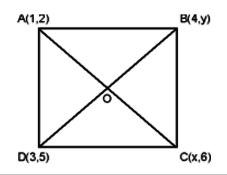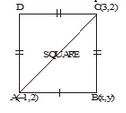10th Grade > Mathematics
COORDINATE GEOMETRY MCQs
Coordinate Geometry
:
Formula: 1 Mark
Application: 1 Mark
Answers: 1 Mark
We know that the diagonals of a parallelogram bisect each other.
∴ The coordinates of the mid-point of AC = The coordinates of the mid-point of BD i.e.
If A(x1,y1),B(x2,y2),C(x3,y3) and D(x4,y4) are the vertices of parallelogram ABCD, Then
x1+x32,y1+y32=x2+x42,y2+y42
⇒(−2+42,−1+b2)=(a+12,0+22)
⇒(1,b−12)=(a+12,1)
⇒a+12=1 and b−12=1
⇒a+1=2 and b−1=2
⇒a=1 and b=3
:
Formula: 1 Mark
Application: 1 Mark
Answer: 1 Mark
Let the given points be A(4, – 1), B(6, 0), C(7, 2) and D(5, 1) respectively. Then,
Coordinates of the mid-point of AC are
(4+72,−1+22)=(112,12)
Coordinates of the mid-point of BD are
(6+52,0+12)=(112,12)
Thus, AC and BD have the same mid-point.
Hence, ABCD is a parallelogram.
Now
Distance between the points is given by
√(x1−x2)2+(y1−y2)2
So,
AB = √(6−4)2+(0+1)2=√5
BC = √(7−6)2+(2−0)2=√5
∴ AB = BC
So, ABCD is a parallelogram whose adjacent sides are equal.
⇒ ABCD is a rhombus.
We have,
AC = √(7−4)2+(2+1)2=3√2 and ,
BD = √(6−5)2+(0−1)2=√2
Clearly, the diagonals AC ≠ BD.
So, ABCD is not a square.
:
Formula: 1 Mark
Concept: 1 Mark
Answer: 2 Marks
Let D, E, F be the mid-points of the sides BC, CA and AB respectively.
Then, the coordinates of D, E and F are
D(5+32,3−12)=D(4,1),
E(3+72,−1−32)=E(5,−2)
and F(7+52,−3+32)=F(6,0)
Distance between the points is given by
√(x1−x2)2+(y1−y2)2
∴AD=√(7−4)2+(−3−1)2
⇒AD=√9+16=5 units
BE=√(5−5)2+(−2−3)2
⇒BE=√0+25=5 units
and, CF=√(6−3)2+(0+1)2
⇒CF=√9+1=√10 units
:
Concept : 1 Mark
Application : 1 Mark
Calculation : 2 Marks
Consider a parallelogram ABCD .
Let O be the point of intersection of the diagonals AC and BD
We know that diagonals of a parallelogram bisect each other.
⇒ O is the midpoint of both the digonals AC and BD
Now, coordinates of O as mid-point of BD are
O(x,y)=(x1+x22),(y1+y22)
⇒O(a,b)=4+32,y+52……(1)
Also, coordinates of O as mid-point of AC are
O(a,b)=1+x2,2+62……(2)
From (1) and (2), we have
4+32=1+x2
72=1+x2⇒x=6
And y+52=2+62
y+52=82⇒y=3
:
Formula for centroid and mid-point: 1 Mark each
Let A(x1,y1),B(x2,y2) and C(x3,y3) be the vertices of triangle ABC.
Let P(1,1), Q(2,-3), R(3,4) be the mid-points of sides AB, BC and CA respectively.
Then, P is the mid-point of BC
⇒x1+x22=1,y1+y22=1
⇒x1+x2=2 and y1+y2=2……(1)
Q is the mid-point of AB
⇒x2+x32=2,y2+y32=−3
⇒x2+x3=4 and y2+y3=−6……(2)
R is the mid-point of AC
⇒x1+x32=3,y1+y32=4
⇒x1+x3=6 and y1+y3=8……(3)
Adding (1),(2) and (3) we get,
x1+x2+x2+x3+x1+x3=2+4+6
and y1+y2+y2+y3+y1+y3=2−6+8
⇒x1+x2+x3=6……(4)
and y1+y2+y3=2……(5)
The coordinates of the centroid of △ABC are
(x1+x2+x33,y1+y2+y33)=63,23=2,23 [Using (4) and (5)]
:
Formula: 1 Mark
Calculations: 2 Marks
Answer: 1 Mark
For points A,B,C to be collinear, area of triangle ABC formed by these points should be zero.
⇒ The area of ΔABC=0
⇒12[x1(y2−y3)+x2(y3−y1)+x3(y1−y2)]=0
⇒12[k(2k−6+2k)+(–k+1)(6–2k−2+2k)+(–4–k)(2–2k−2k)]=0
⇒12[k(4k−6)+(–k+1)(4)+(–4–k)(2–4k)]=0
⇒12[4k2−6k−4k+4−8+16k−2k+4k2]=0
⇒8k2+4k−4=0
⇒8k2+4k−4=0
⇒2k2+k−1=0
⇒(k+1)(2k−1)=0
⇒k=−1 or k=12
:
Concept : 1 Mark
Application : 1 Mark
Calculation : 2 Marks
Let ABCD be a square and two opposite vertices of it are A(-1, 2) and C(3, 2). ABCD is a square.
Since ABCD is a square.
⇒AB=BC
⇒AB2=BC2
[Distance between the points is given by
√(x1−x2)2+(y1−y2)2]
⇒(x+1)2+(y−2)2=(x−3)2+(y−2)2
⇒x2+2x+1=x2−6x+9
⇒2x+6x=9−1=8
⇒8x=8⇒x=1
ABC is right Δ at B, then
AC2=AB2+BC2 (Pythagoras theorem)
⇒(3+1)2+(2−2)2=(x+1)2+(y−2)2+(x−3)2+(y−2)2
⇒16=2(y−2)2+(1+1)2+(1−3)2
⇒16=2(y−2)2+4+4⇒2(y−2)2=16−8=8
⇒(y−2)2=4⇒y−2=±2⇒y=4 and 0
i.e when x = 1 then y = 4 and 0
Co-ordinates of the opposite vertices are: B(1,0) or D(1,4)
:
Concept : 1 Mark
Application : 1 Mark
Calculation : 2 Marks
Area of quadrilateral ABCD=|Area of ΔABC|+|Area of ΔACD|
We have,
∴ Area of ΔABC=12|(1×−3+7×2+12×1)−(7×1+12×(−3)+1×2)|
⇒ΔABC=12|(−3+14+12)−(7−36+2)|
⇒ΔABC=12|23+27|=25sq.units
Also, we have
∴ Area of ΔACD=12|(1×2+12×21+7×1)−(12×1+7×2+1×21)|
⇒ΔACD=12|(2+252+7)−(12+14+21)|
⇒ΔACD=12|261−47|=107sq.units
∴ Area of quadrilateral ABCD = 25 + 107 = 132 sq. units




















